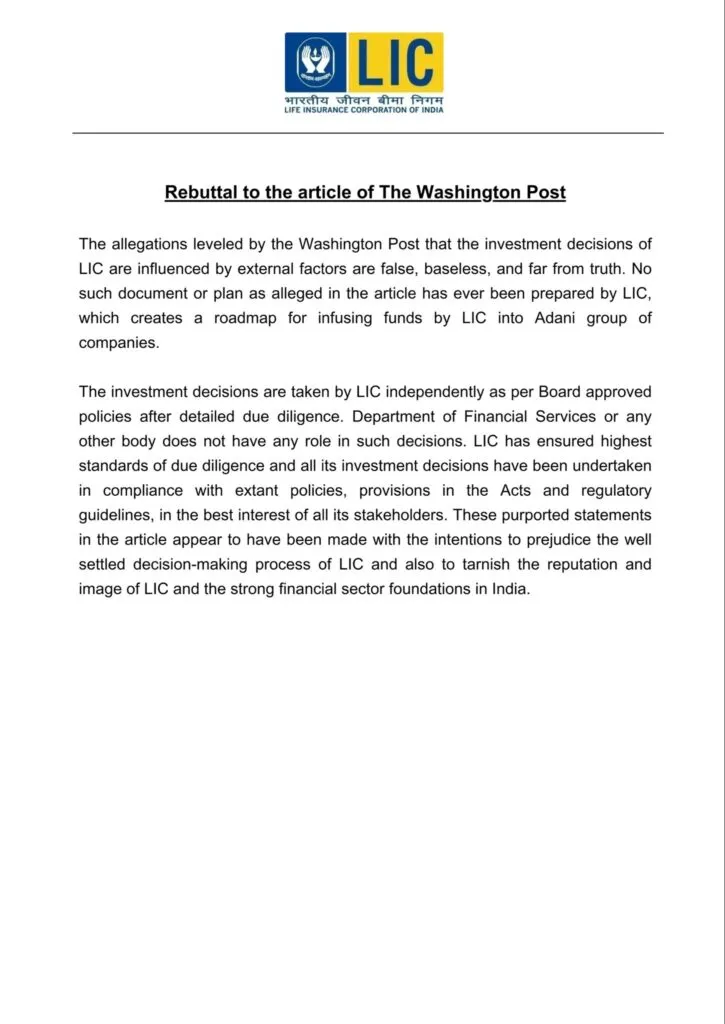According to a report by The Washington Post, officials in India’s Finance Ministry helped speed up a plan for the Life Insurance Corporation of India (LIC) to invest about $3.9 billion in Adani Group companies, even though they knew the investments were risky. This happened when the Adani Group was struggling to get loans from global banks after a U.S. bribery case against it. LIC later invested ₹5,000 crore in Adani Ports through long-term bonds. The report says officials wanted LIC to also invest in Adani Green Energy and Ambuja Cements, saying these investments gave better returns than government bonds. However, both LIC and Adani Group have strongly denied the allegations, saying that LIC’s investment decisions are independent, follow all rules, and are made in the best interest of policyholders. The issue has raised concerns about the safety of public money and government influence on investment decisions of state-owned companies.
A recent report by The Washington Post has revealed that officials from India’s Finance Ministry fast-tracked a proposal in May 2025 directing nearly $3.9 billion (around ₹32,000 crore) of investments from the Life Insurance Corporation of India (LIC) into a company owned by the Adani Group, despite being aware of potential financial risks.
According to the report, the proposal came at a crucial time when the Adani Group was seeking funds to refinance its dollar-denominated debt. The Finance Ministry reportedly proposed that LIC invest in Adani Ports and Special Economic Zone Ltd (APSEZ) and Adani Green Energy Ltd, citing higher returns compared to 10-year government securities.
The report added that ministry officials, working through the Department of Financial Services (DFS) and in consultation with NITI Aayog, helped shape the investment plan. Documents reviewed by The Washington Post indicated that the DFS was aware of the risks associated with the plan, given the volatility of Adani’s securities and their exposure to short-term price fluctuations.
The $5,000 Crore Investment
On May 30, 2025, Adani Ports announced it had raised ₹5,000 crore through a 15-year Non-Convertible Debenture (NCD) issue carrying a 7.75% interest rate. The entire issue was subscribed by LIC, with Adani Ports claiming that the investment was supported by its “strong financials” and ‘AAA/Stable’ domestic credit rating.
However, the decision quickly drew criticism from opposition leaders, including Rahul Gandhi, who questioned the use of public funds. “Money, policy, premium are yours; security, convenience, benefit for Adani!” he posted on social media platform X in June 2025.
Context: Adani’s Legal and Financial Troubles
The report also highlighted that in 2024, U.S. prosecutors had charged eight individuals, including Gautam Adani, for allegedly agreeing to pay $265 million in bribes to Indian officials to secure contracts for a solar power project. Following the indictment, global banks became hesitant to lend to the Adani Group, making domestic financing critical for the conglomerate. The Washington Post claims the Finance Ministry’s directive came at this sensitive time when foreign funding options were limited for the Adani Group.
LIC’s Role and Middle-Class Implications
LIC, as India’s largest state-owned insurer and one of the biggest institutional investors, manages the savings of millions of middle-class Indians. Its decisions have a direct impact on policyholders who rely on LIC for long-term, low-risk investments.
The report suggests that LIC requested a “swift review and approval process” for the Adani investment, describing it as “time-sensitive.” The Finance Ministry allegedly recommended that LIC spread its bond investments across Adani companies and consider increasing equity stakes in entities such as Ambuja Cements and Adani Green Energy.
LIC and Government Deny Allegations
Both the Adani Group and LIC have strongly denied the allegations made in the report. In its response, the Adani Group said there were no government directives to channel LIC funds into its companies. “LIC invests across multiple corporate groups — suggesting preferential treatment for Adani is misleading. LIC has earned returns from its exposure to our portfolio,” the company said. Meanwhile, LIC issued a detailed rebuttal, calling the claims “false, baseless, and far from the truth.” It said: “No such document or plan as alleged in the article has ever been prepared by LIC that outlines a roadmap for infusing funds into Adani Group companies.”
LIC clarified that its investment decisions are made independently, with no role for the Department of Financial Services or any external body. The insurer emphasized that it follows the highest standards of due diligence and complies fully with all regulatory and statutory guidelines. The statement further added that the Washington Post article appeared to be an attempt to damage LIC’s reputation and undermine confidence in India’s financial system.

The controversy raises questions about foreign influence, governance, and transparency in the deployment of public funds through state-owned institutions like LIC. Critics argue that while seeking higher returns is important, investments must remain insulated from political pressure and aligned with the interests of millions of small policyholders.